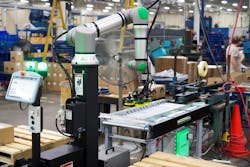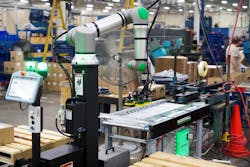Conveyor Trends: Safer, Stronger, Sleeker
Conveyance systems are a linchpin for putting packages into consumers’ hands. Conveyors literally underpin e-commerce; there’s a growing need for them and their associated components. Research from Fortune Business Insights pegged the global conveyor systems market size at $5.4 billion in 2021 and projects sales to hit $7.8 billion by 2029. According to the Bureau of Labor Statistics, warehousing will be the fourth-fastest-growing sector through 2032.
All this growth means e-commerce will need a massive infrastructure to process and fulfill consumer orders. The infrastructure to move packages is also intersecting with several trends shaping the design of conveyance systems. Conveyor buyers say they want improved safety, durability, modularity, sustainability and aesthetics.
Poor Design and Speed Affect Workers
Facilities often react to increased consumer demand by ratcheting up conveyor feed and speed. Higher speeds lead to vibration and higher decibel levels, often into the high 90s dB(A). If the noise level exceeds 88 dB(A) for four hours, the National Institute of Occupational Safety and Health say workers have reached their maximum allowable daily dose of noise and further exposure is hazardous. Elevated noise from conveyors has resulted in fines for some employers, so there’s a desire on the part of industry to reduce the decibel level to a safer range.
READ MORE: Smart Conveyor Control Using VFDs and Sensors
Designing conveyance systems that reduce hard surface contact is another way to bring noise levels down. Coating roller tubes can be an effective approach to sound reduction. With the right combination of components, it’s possible to reduce the decibel level from the high 90s to the 70s. While the optimum situation is reducing the potential for noise during the design and installation of conveyance systems, maintenance managers can also reduce sound by retrofitting conveyors with rollers with proprietary urethan blends. These coatings have a low durometer but still maintain high abrasion resistance. There are also vibration dampening opportunities when mounting conveyor sections to a facility’s floor.
With humans interfacing with the conveyance system, there are other types of injuries resulting from poor design. As the scale of warehousing has grown, there has also been an uptick in citations by OSHA for employers exposing workers to ergonomic hazards, such as employees awkwardly twisting or extending to lift boxes.
Injuries happen when a conveyor isn’t adjustable. Think about workers of varying heights standing at a conveyor and lifting packages at different angles. When there are uneven transition points between conveyor sections, a worker might twist uncomfortably and lift to adjust a package. Ergonomic designs that bring the package to an employee can reduce the number of manual adjustments workers need to make to packages winding along a conveyor. By designing conveyors with adjustable human interface points, engineers can eliminate strains and sprains.
READ MORE: Automate 2024: Pallet Handling Systems from mk North America Inc.
“FlipRail conveyance systems enable an end-user to have rollers set at different heights, low and high, depending on what workers need,” said Nic Marois, chief revenue officer for MODO8, a maker of conveyor systems, components and robotic solutions. “That kind of innovation improves safety, ergonomics and flexibility for growth.”
Durability Through Variety
Material design and selection as well as tighter tolerances for conveyors have changed over the past five years. Conveyor manufacturers and the integrators who assemble components and install entire systems are looking at more efficient designs, with fewer parts, a longer service life and higher package speeds. As designers push the velocity limits on conveyance systems, it strains traditional components, especially conveyor rollers and bearings, leading to reduced life cycle and premature failure. So, designers are looking for ways to make rollers turn truer and paying closer attention to total indicator reading, or TIR, so rollers have less eccentric loading in the system.
Historically, conveyor rollers were overwhelmingly made of steel. And while high-strength steel is still an option for its load-bearing capacity, aluminum rollers are a lightweight option that resist corrosion. Engineered plastics, too, can resist chemicals or offer non-conductivity if needed.
Large manufacturers of conveyance systems have the resources to evolve designs. But often these novel designs rely on components and materials that aren’t commonly available. This means procuring specialty products that cost more than widely available components and sizes. For instance, a conveyor manufacturer might design tubing for a system that measures, say, 2.85 inches instead of a standard 3.00-inch sized tube. By consulting component manufacturers during the design phase, engineers can often save costs while still innovating. Component makers can help with material selection and manufacturing techniques to achieve innovative outcomes.
In addition to selecting proper materials, designers and buyers can upgrade standard rollers with tighter machining tolerances, precision bearings, and even straightening or balancing to improve concentricity and TIR, resulting in higher speeds and longer life.
READ MORE: Are Metal Conveyor Belts Right for Your Application?
Warehousers and procurement officers likely think a roller is just a roller if they think at all about components. The buyers of conveyors want to move a product and ensure the conveyance system is easily repaired and lasts a long time. But with inexpensive—or improper—designs, a warehouse will likely replace major sections or components of a system, or the entire unit, and buy a new one (or even two) in half the time a well-designed system lasts (e.g., more than 15 years). That’s double (or triple) the cost in less time than a quality product’s lifespan. Improperly selected components can cause excessive wear and premature failure at high speed or heavy weight.
There are well-designed conveyance systems still functioning after 20 years. And existing conveyance systems often gain added years of life by swapping worn components with superior quality replacements. For these reasons and more, design engineers have much evidence for making the case for total cost of ownership, or TCO, by showing data for how inferior or improperly designed components wear out faster and stress the overall design.
An Eye on Sustainability
Customer initiatives and environmental concerns are pushing makers of conveyors and components to look at reusing materials and refurbishing systems. If manufacturers can reuse more of the base steel and framework of conveyors while removing and reusing components, the effort saves the money and energy to manufacture new parts. That approach also reduces material waste and components potentially headed for landfills.
Makers of conveyance systems and components are also developing ultra-efficient products to consume less power. These include HSLA (high strength low alloy) material or aluminum in lieu of low carbon steel to reduce weight and the power needed to drive rollers.
Brushless motors coupled with modern belt designs can improve power transfer and reduce the total number of motors required in system. Properly designed bearings can reduce drag or friction on a system resulting in reduced HP motors and lower power consumption. The challenge lies in balancing sustainability with the need for durable, long-lasting equipment that handles industrial demands.
Separating and Recombining Conveyors for the Job
Conveyor buyers want systems that handle a wide range of products. The items a warehouse moves might be fragile electronics or bulky furniture. To meet the need, conveyor manufacturers and designers are offering equipment users can configure to handle various sizes and shapes of packages.
If, for instance, a warehouse has four dock bays, but typically uses two, a facility manager may want a flexible, lighter-weight conveyance system they can separate quickly to service all four doors. A facility may run 30,000 units of product and want the ability to ramp up to 80,000 units. In this case, managers might opt for a system that is modular—one they can add on to.
“Modularity is the future,” adds MODO8’s Marois. “End-users don’t want to redesign a system they’re currently using to merge or divert products; they want to easily tie together sections of conveyors whether they are motor-driven rollers or gravity conveyors.”
Conveying a Cleaner Look
Until recently, conveyor designers and manufacturers primarily focused on function. But buyers are now thinking about esthetics driven by the end user’s requirements. They want, for instance, rollers that won’t rust with brighter, more cosmetic design. To deliver a sleek looking product, component makers are improving surface coatings and focusing on polishing to improve the overall appearance.
Integrators, too, want to work with the conveyor manufacturers offering the cleanest, shiniest and most refined product for the market. Driving the attention on aesthetics is a desire by warehousing and logistics companies to create clean, well-lit facilities that attract workers and impress customers, investors, inspectors and others who are touring these locations in person and virtually. In the last 10 months, we’ve toured a dozen facilities; each one has shown off its capabilities and allowed people to ask questions about its function and operation.
Looking Ahead
Whether the motivation is employee retention or avoiding injuries and fines, employers are focusing more intently on retaining workers and protecting employees’ health. Managers will increasingly want ergonomic conveyance systems that bring products more comfortably to the worker’s range of motion and reduce lifting and turning.
Cobots and AGVs, which are robots that can share a common space with humans while assisting them, will appear more in conveyance lines in the future. These machines will help workers load and unload products. Cobots are in fact a natural progression for conveyance, since conveyors are the foundation of automation whether that is taking products from or delivering them to a point of use. There are, of course, added up-front costs with implementing, integrating and maintaining automated robotic units as part of conveyance systems. But if employees continue retiring in greater numbers than companies can find replacements, cobots are one way to extend the abilities of humans in the conveyance loop.
Along with ergonomics, look for more focus on reducing excessive (sometimes harmful) noise levels causing employee turnover. There has been a major effort by industry to reduce the overall noise in facilities, especially in the zones most frequented by employees. New products will incorporate sound mitigation and vibration dampening materials to achieve these goals.
Jason Hensley is the vice president of Sales at ProVeyance Group and brings over 20 years of expertise in the manufacturing industry. He has a bachelor’s degree from Hillsdale College. Adam Webster is vice president of Engineering & Innovation for ProVeyance Group. He is an expert in lean manufacturing and holds a professional engineer license and LEED AP certification. He earned his bachelor’s degree from The University of Toledo.


